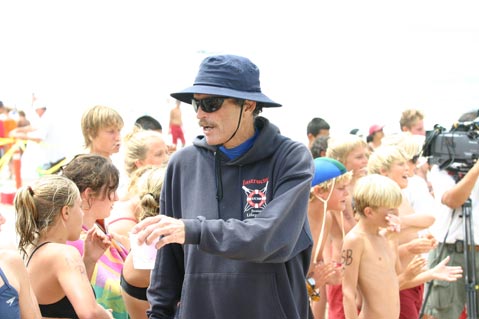Rob Gibson: Lifeguard
1949-2009

Rob Gibson devoted his life to the development of youth aquatics. Thousands of children in Santa Barbara County will forever enter a pool, lake, or ocean remembering that their swimming initiation came as part of a lesson or Junior Guard program organized by a tall, tan, impossibly thin man invariably clad in trunks, shades, and a lifeguard sweatshirt.
Rob’s swimming lessons were always free. For most of the youngsters who took them, Rob’s programs marked the first time they had ever walked onto a pool deck. Rob funded the classes by writing grant applications to regional philanthropic organizations like the Santa Barbara Foundation.
Rob followed in the footsteps of his older brothers Samuel, James, and Joseph in developing the skills to compete in swimming and water polo and in becoming a lifeguard. In 1967, he chose UCSB for its aquatics programs and proximity to the ocean, swimming and playing water polo for coaches Rick Rowland and Dante Dettamanti, and breaking Jim Ranta’s longstanding record in the hundred butterfly.
Rob worked as a lifeguard after college, then returned to UCSB in the early ’80s to earn a teaching credential. He took a job teaching history in the Santa Maria School District, and lasted two painful years away from the coast. Rob needed to live near the ocean. So he resumed lifeguarding, and worked as a mechanical draftsman while completing a degree in computer science. He excelled at programming, invested wisely, lived frugally, and achieved a degree of financial independence by the early ’90s. At age 58, Rob placed in the top six at the annual state lifeguard requalification.
During the summers, Rob helped build a powerhouse Junior Guard (JG) Program at Refugio Beach, which introduced numerous children to the wonders of the Gaviota Coast and competed with the longstanding Santa Barbara JGs. For many pupils, the JG experience helped define a lifelong love for the ocean. Rob included underprivileged and low-income children by writing grants for scholarships and fee waivers. Shifting his focus to UCSB’s summer aquatics program in 2006, Rob grew it from a camp into two full JG sessions that competed in local and state contests. During the fall and winter months, he coached introductory swimming for the Santa Barbara Water Polo Club, helping to build it into the nation’s best by encouraging promising athletes to pursue higher levels of competition.
Rob formed the nation’s first comprehensive Third Grade Swim Program in 2005, modeling it after a city program in Pasadena that targeted low-income children. He worked tirelessly with the Goleta Union School District’s superintendent and teachers, as well as the South Coast Community Aquatics Center, to coordinate lessons for more than 500 children each year.
Integrating swim lessons into the academic schedule is very difficult, and yet Rob persevered. Each principal and staff posed new challenges. I recall sitting with Rob on a stage in front of parents and teachers as he calmly explained the value of swim lessons. To the occasional teacher or parent who insisted that “it is better to have swimming lessons in the summer like everybody else,” Rob gently explained that many parents who work in the summer cannot take their children to swim lessons.
Rob proved that 3rd grade is an optimal age for swimming, even for children who have never entered a pool in their lives. Each child received a swimming suit and goggles. Lessons took place during school hours and Rob provided teachers with drying racks so that kids would be ready to go for the next day’s session. No matter what their income, every child wore the same suit. Rob understood that the Third Grade Swim Program was about more than reaching the ascribed goal of swimming 25 yards unassisted: Self-esteem was also of the utmost importance. Rob pointed out that just putting on a bathing suit can be awkward for youngsters unfamiliar with pool culture. The Third Grade Swim experience made short work of this hurdle as kids of all shapes, sizes, and colors charged the pool.
Assembling instructors to teach droves of 3rd graders in the middle of the working day is also a gargantuan task. Rob employed a legion of UCSB students to teach kids the fundamentals. When the lessons shifted to Elings Pool, Rob’s instructors followed him, meeting school buses and teaching kids.
Rob Gibson was an exceedingly private person, and yet, when it came to aquatics, he inspired people young and old. His focus, however, was always on the kids: “How are those kids going to feel if we can’t get a pool for lessons this month? How many kids can I fit into Junior Guards?” Rob met every challenge, providing special instruction for handicapped children, and for older kids who wanted to tagalong with the 3rd graders.
Nobody ever forgets learning to swim, clinging to the side with a voice telling you to “let go and swim to me.” Rob Gibson made that day happen for many children who otherwise might never have ventured into the water. Among other things, Rob’s goal of helping traditional non-swimmers propel themselves for 25 yards is an important step toward preventing drowning, the second leading cause of death among children 14 and younger. Rob looked past the norm and created a framework for helping all children let go of the wall. Replacing Rob Gibson is impossible, but one can hope that we will learn from his exemplary life.



